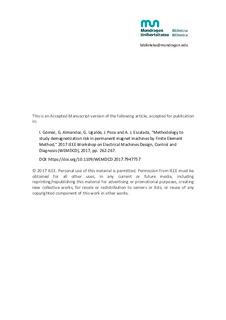
Título
Methodology to Study Demagnetization Risk in Permanent Magnet Machines by Finite Element MethodAutor-a (de otra institución)
Fecha de publicación
2017Grupo de investigación
Accionamientos aplicados a la tracción y a la generación de energía eléctricaOtras instituciones
Orona S.Coop.Versión
PostprintTipo de documento
Contribución a congresoContribución a congresoIdioma
InglésDerechos
© 2017 IEEEAcceso
Acceso abiertoVersión de la editorial
https://doi.org/10.1109/WEMDCD.2017.7947757Publicado en
IEEE Workshop on Electrical Machines Design, Control and Diagnosis (WEMDCD) Nottingham. 20-21 April. Pp. 262 - 267. IEEE, 2017Editorial
IEEEPalabras clave
demagnetization
Magnetic flux
Finite element analysis
Magnetic circuits ... [+]
Magnetic flux
Finite element analysis
Magnetic circuits ... [+]
demagnetization
Magnetic flux
Finite element analysis
Magnetic circuits
Temperature measurement
Robustness
Torque [-]
Magnetic flux
Finite element analysis
Magnetic circuits
Temperature measurement
Robustness
Torque [-]
Resumen
Nowadays the majority of applications are demanding more and more compact, cost effective and robust solutions for their electric drives. In this context permanent magnet synchronous machines are cons ... [+]
Nowadays the majority of applications are demanding more and more compact, cost effective and robust solutions for their electric drives. In this context permanent magnet synchronous machines are considered as a good candidate due to their high torque density. This torque density is obtained thanks to high power rare earth magnets with both high remanence and high coercive force. However, the magnets cost has a relevant impact in the final cost of the electrical machine and the uncertainty shown by the rare earth market in the last years has originated high variations in the price of them. Due to that, it is essential to reduce this impact in order to accomplish cost effective drive solutions. Some key points to face this problem are the reduction of the magnets volume or the using of magnets with worse thermal properties (magnets with few dysprosium and with low coercive force). In both cases special attention must be paid on the demagnetization risk of the magnets. To carry out that analysis, in this article a finite element method simulation analysis process for demagnetization of permanent magnets is presented. The developed method has been validated experimentally in a test bench. Good agreement is shown between simulations and experimental results. [-]
Colecciones
- Congresos - Ingeniería [436]




















